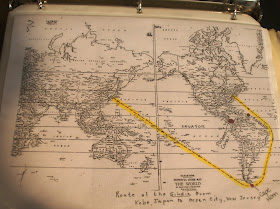 |
| An artist's rendering of the Ocean City Community Center. |
It was an ordinary day. Driving along the streets of Ocean City, New Jersey, searching for the Ocean City Historical Society Museum. The Museum is located inside the Ocean City Community Center which also houses the Public Library and the Arts Center. It is located at 1735 Simpson Ave., Ocean City, NJ. After I found the building, I parked the car and headed up the steps to the building. Made an immediate left after entering the building and was standing inside the museum. Found the "Sindia Room" and began viewing the many books and looking at several notebooks which displayed photos taken over the years by people who lived nearby as well as other photographers. My story today will be a visual one as I show you what remains of the grand Sindia. It was another extraordinary day in the life of an ordinary guy.
 |
| Photo taken a few days after the Sindia ran aground. Clickk on photos to enlarge them. |
 |
| This is a 1902 newspaper telling of items that have been salvaged from the ship. |
 |
| Dated the 1930s and shows two young women lounging on what remains of the ship. By the mid-1980s all was lost to the sand. |
 |
| A color photo showing bathers swimming near the wreck. |
 |
| A photo in a newspaper showing a piece of the ship at high tide. |
 |
| This is an early photo showing removing cargo after the storm. |
 |
| This photo and the three following show some of the porcelain that has been recovered. |
 |
| The ship's wheel or what is known as the "helm." |
 |
| Great photo showing the ship with crew before the storm. |
 |
| This is the Octant which was used for navigation on the open seas. |
 |
| The Sindia's sextant which was used to determine the angle between the horizon and celestial bodies (usually the Sun). |
 |
| This map charts the route that the Sindia took on it's fateful journey. |
 |
| This is a reproduction of the figurehead on the ship. It portrays the Maharajah Jaihi Rao Sindia who ruled from 1846 to 1886 in Gwalier, India. |







No comments:
Post a Comment